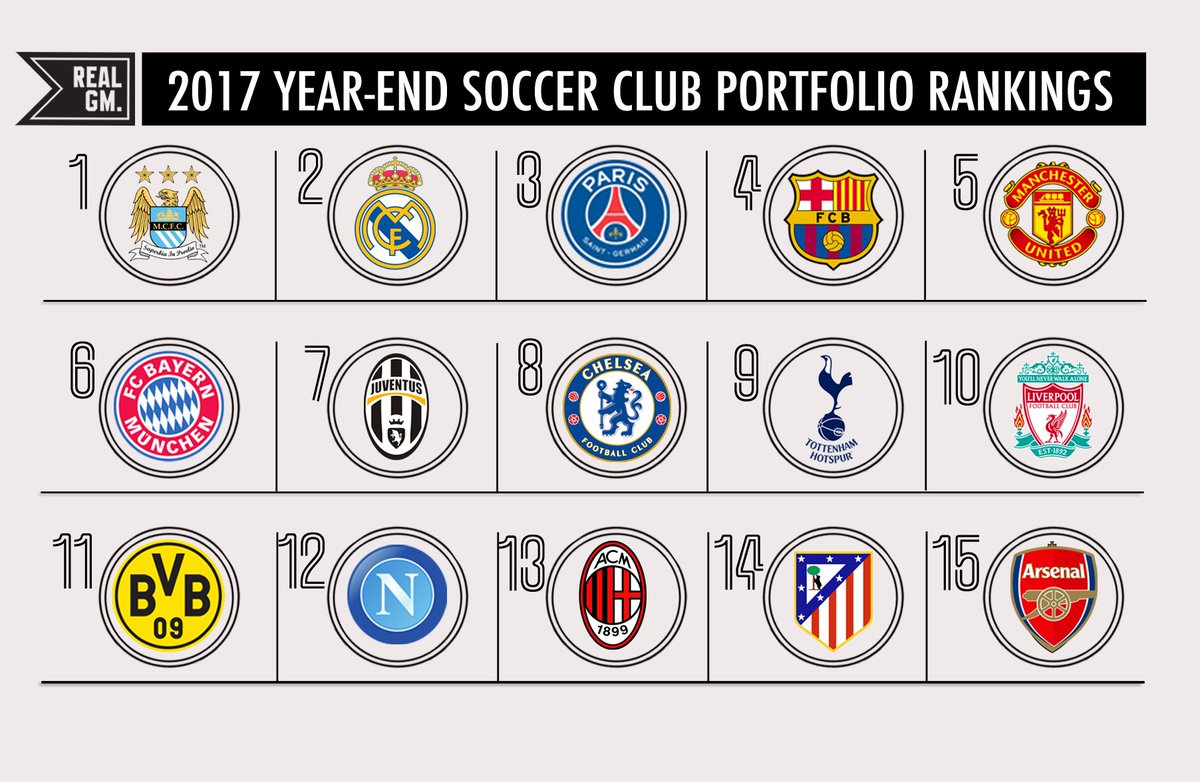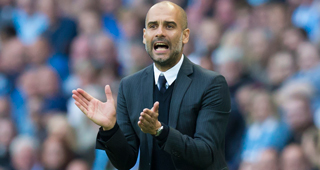For the third consecutive year, we have created a year-end club portfolio ranking. The exercise is to evaluate every club as if they were a portfolio of assets to determine which is most valuable.
The only considerations are talent, age, contract situations and youth system with the goal being to eventually compete for and win every major trophy available to them. An older team already contending is more valued than a younger team with a ton of talent that may not get there, but the younger team with upside is a better bet than an older team that’s currently better but without the upside.
There is no consideration given to club history, current manager or ownership.
Soccer has a fairly solidified yet ever-changing landscape, but this creation of a hierarchical ranking gives a look to how we would choose their collective situations at the end of 2016. Last year's rankings are in parenthesis, which you can read here and 2015 here.
- Also see RealGM's Year-End Team Portfolio Rankings for the NBA, NFL, MLB.
15. Arsenal (9): Arsenal has dropped from sixth at the end of 2015 to ninth at the end of last year to barely remaining in our top-15. They’ve let their two best talents, Alexis Sanchez and Mesut Ozil, enter the final months of their contracts without an extension and without a sale that would allow them to fund their replacements out on a transfer market Arsene Wenger fears. Ozil could still re-sign but Sanchez is all but gone. Alexandre Lacazette is already proving to be a typical Arsenal player with how he looks the part and then disappears for matches at a time. It is difficult to envision Arsenal remaining on this list at the end of 2018 without a real shift in Arsene Wenger’s approach.
14. Atletico Madrid (5): Diego Simeone’s side is in flux with Antoine Griezmann rumored to leave sometime this summer. He is the team’s most dynamic player, and relied upon to create a game winning moment when matches bog down into the Atleti brand of tackling, clearances and hopeful long balls. But they have resources returning in the winter with striker Diego Costa and winger Vitolo adding more directness and pace into the attack. In Koke, Saul and Thomas Partey, Atleti have a midfield core under the age of 25. And keeper Jan Oblak is still just 24 years old. Other foundational players are aging, especially in defense, knocking them down the list from last year. And their array of mid-20’s wingers like Angel Correa and Yannick Carrasco have failed to make a consistent impact thus far. But Atleti, as much as any other side on this list, is more than the sum of their parts. -YM
13. AC Milan (12): A common theme of this list is a side filled with talented individuals collectively underachieving in the domestic league. No side fits that description more than AC Milan, who spent more than $250 million in last summer’s transfer window, capped by a symbolic move for Juventus center back Leonardo Bonucci. A slow start got manager Vincenzo Montella fired and they’re currently sputtering in 11th place and 14 points out from a Champions League position. Yet there is hope. Although keeper Gianluigi Donnarumma’s future is unsettled, he and midfielder Manuel Locatelli are still teenagers. The summer spending spree brought youth in 21-year-old midfielder Franck Kessie, 22-year-old striker Andre Silva and 23-year-old right back Andrea Conti. On names alone, the side should be competing for a Serie A title. But with another potential sale of the team on the horizon, we may never see that talented core develop together. -YM
12: Napoli (NR): Napoli’s biggest star is their free flowing, passing style - which is to say that their biggest star is manager Maurizio Sarri. The social media focus on their collective sequences passing out of the back under pressure can overshadow the individual quality of their players. The core of the side are in their prime or just towards the end: captain Marek Hamsik, striker Dries Mertens and right winger Jose Callejon are 30 years old, while playmaker Lorenzo Insigne and deep lying passer Jorginho are both 26. Yet there is an injection of youth with Amadou Diawara and Elseid Hysaj. They all can pass, dribble and shoot, and they make each other look even better doing so. Hamsik’s personality will be difficult to replace, but the prospect of a new generation having developed under Sarri-ball makes for an exciting future even if the level of their individual skill isn’t fully appreciated. -YM
11. Borussia Dortmund (4): Like Milan, Borussia Dortmund’s gifted but underachieving side cost their manager his job. A strength of laying out a club portfolio list year by year is in analyzing how far a team moves up or down, and how much squad can seemingly age in just 12 months. It doesn’t seem long ago that Dortmund was the most exciting side in Europe with a young, pacy and skilled attack lead by an equally talented manager, and the lesson here would be in the melancholy of waiting for a tomorrow that never comes. The foundation of this era is aging - Marco Reus and Pierre-Emerick Aubameyang are each 28 years old and Mario Goetze is 25. There is a young foundation lead by Christian Pulisic, Julian Weigl and Mahmoud Dahoud, but it’s up to a manager to get the most out of this squad before the magic is gone. -YM
10. Liverpool (NR): Barcelona threw the kitchen sink at Liverpool to buy Philippe Coutinho in the summer and they successfully resisted multiple offers. He’s remained one of the most dynamic players in the world and will be even more expensive in January should he finally be sold. The £39 million transfer with Roma for Mohamed Salah has already proven to be a tremendous bargain as has the Sadio Mane deal from the previous summer. Adding Virgil van Dijk was shockingly expensive but he'll bring stability to their inconsistent defense. Liverpool has one of the youngest cores in the world and will remain very good for a long time. -CR
9. Tottenham Hotspur (14): All Harry Kane does is score goals as he’s become one of the best finishers in the world. Christian Eriksen and Son Heung-Min are ideal supporting players for Kane in attack. The difference between top-4 in the Premier League Spurs and the Spurs that can beat any club in the world is whether Dele Alli plays with force. He’s been inconsistent but is still just 21 and certainly has another level he’ll hit in his development. -CR
8. Chelsea (7): While they won’t successfully defend their 2017 Premier League title, they certainly haven’t slipped the way they did after they last won it in 2015. Eden Hazard, N’Golo Kante, Alvaro Morata, Thibaut Courtois and Tiemoue Bakayoko are firmly in their mid-twenties and remain a core that will challenge for trophies for as long as Roman Abramovich continues to pay for supporting pieces around them (or bring their young talents home from loan). -CR
7. Juventus (6): With a core in their late 20s and early 30s, Juventus are old. But this generation of Juventus, the one with six straight Serie A trophies and two Champions League finals in three seasons, have always been an old club. Whether that’s Gonzalo Higuain, Mario Mandzukic, Sami Khedira, Blaise Matuidi each crossing the 30 mark, or Andrea Barzagli and Gigi Buffon pushing 40, their age has yet to catch up to them in trophies. But future personnel decisions must focus on building a side around Paulo Dybala. They brought in winger Federico Bernardeschi last summer, but at some point, they’ll have to renew the midfield. That they have been this successful, and remain this successful, is attributed to savvy player moves and managers who know exactly how to get the most out of each player. -YM
6. Bayern Munich (3): Already 11 points up in the Bundesliga by the winter break, Bayern Munich have the double edge sword of cruising in league matches while recommitting their intensity for their Champions League campaign. Granted, it’s a “problem” only reserved for the biggest sides, but has a tangible impact on European results. The attacking four of Arjen Robben, Robert Lewandowski, Franck Ribery and Thomas Muller are aging. The club brought in youthful foundation to build upon with Kingsley Coman, Niklas Sule and Corentin Tolisso, and Joshua Kimmich is still just 22. Their only focus is Champions League success, and they’ll need their entire lineup - from elder statesmen to youth - at their highest level come the midweek. –YM
5. Manchester United (11): United has spent wildly over the past few years and are still grasping for a coherent roster. The individual young talents of Paul Pogba, Marcus Rashford, Anthony Martial and Romelu Lukaku are undoubtedly impressive but they have lacked chemistry. Jose Mourinho is perhaps overreliant on older players like Ashley Young, Nemanja Matic, Marouane Fellaini and Zlatan Ibrahimovic. -CR
4. Barcelona (2): Lionel Messi remains the world’s best player and they’re running away with La Liga, but age has been coming for this team, especially with Neymar leaving and their string of underwhelming transfers. While Real Madrid has pieces in place to envision what a world post-Cristiano Ronaldo would look like, that’s not the case for Barcelona. Perhaps Messi will be able to play at a Ballon d’Or level for another five years as a deep-lying playmaker while they rebuild. The results are still there in the meantime. -CR
3. Paris Saint-Germain (10): If injuries and stilted player develop are a common theme in clubs moving down this list, then the most direct way to move up here is through spending. Neymar and Kylian Mbappe on name and age alone are enough to enter the elite tier. And that’s also alongside midfielder Adrien Rabiot, still just 22 years old. Their top level talent is as good as any side in the world. Yet the subtle reason separating this side from the top two clubs is the imbalance between PSG’s biggest names and the rest of the squad. While Edinson Cavani is on pace for his most prolific year yet, and Marco Verratti still remains one of the most skilled midfielders of his generation, that gap between attack and defense may prevent them from reaching their full potential in the Champions League as well. -YM
2. Real Madrid (1): Like Barcelona, Real Madrid is suddenly looking old in parts of their very familiar XI with Ronaldo, Luka Modric, Marcelo, Sergio Ramos and Karim Benzema at the age of 29 or older. Gareth Bale, for what it’s worth, is 28 and can never stay healthy for more than a month at a time. The difference for Madrid is they have foundational players in Isco, Casemiro, and Marco Asensio who are just about to hit their primes, while Toni Kroos has become one of the world’s best midfielders at the age of 27. The pieces haven’t fit quite as well this season in La Liga or even the Champions League, which is why they drop a spot despite remaining the best and deepest club in the world. -CR
1. Manchester City (8): While this list doesn’t take manager quality into account, it is hard to separate what Pep Guardiola’s system turns players into from their natural talent. Either way, City has been the best club in the world since August and also are incredibly young in attack. Kevin De Bruyne has been the best player in the world not named Messi, Ronaldo and maybe Neymar. Sergio Aguero doesn’t enjoy being rotated as much as he has but it should prolong his career. Behind those two and David Silva in attack, is 23-year-old Raheem Sterling, 21-year Leroy Sane and 20-year-old Gabriel Jesus. While not at the level of the PSG duo, that young trio is impossibly good at such a young age. -CR




